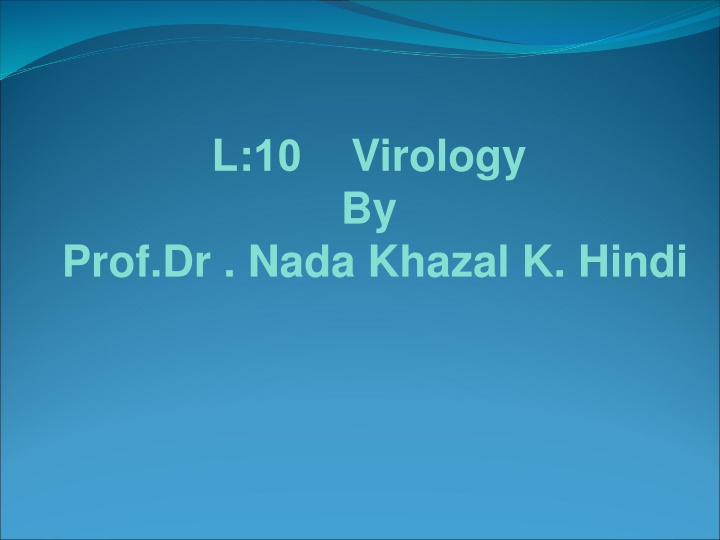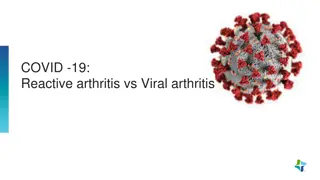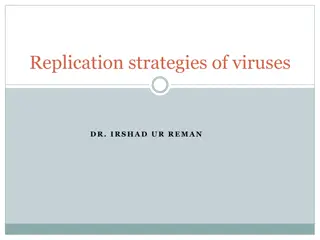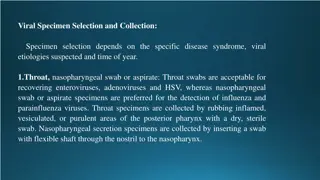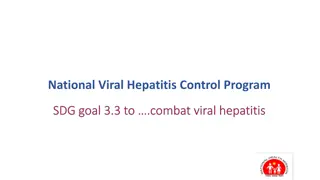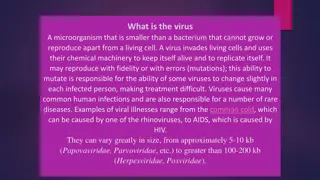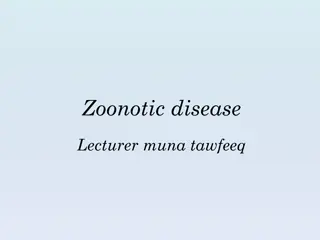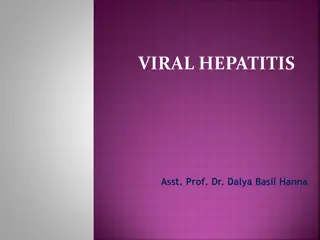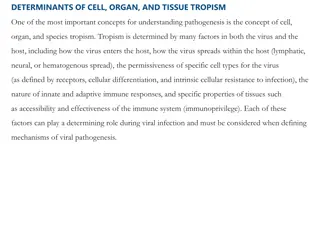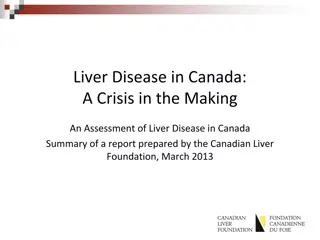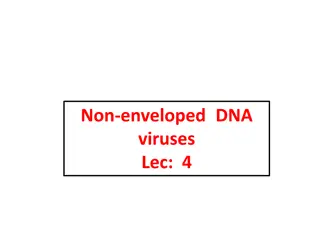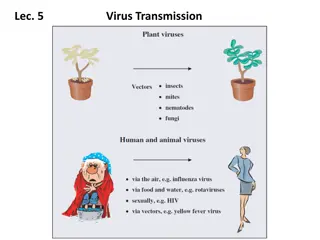Overview of Hepatitis Viruses & Viral Hepatitis
Hepatitis viruses come in 5 types - A, E, B, C, D - each transmitted differently, causing liver inflammation. Acute or chronic, with various symptoms, risks, and complications. HBV detailed with transmission info and structure. Effective vaccine available for HBV.
Download Presentation

Please find below an Image/Link to download the presentation.
The content on the website is provided AS IS for your information and personal use only. It may not be sold, licensed, or shared on other websites without obtaining consent from the author.If you encounter any issues during the download, it is possible that the publisher has removed the file from their server.
You are allowed to download the files provided on this website for personal or commercial use, subject to the condition that they are used lawfully. All files are the property of their respective owners.
The content on the website is provided AS IS for your information and personal use only. It may not be sold, licensed, or shared on other websites without obtaining consent from the author.
E N D
Presentation Transcript
L:10 Virology By Prof.Dr . Nada Khazal K. Hindi
Hepatitis Viruses: there are 5 types The Transmission of Hepatitis Viruses are following 1. Hepatitis A Viruses (HAV): by fecal oral rout 2. Hepatitis E Viruses (HEV): by fecal oral rout 3. Hepatitis B Viruses (HBV): by all body fluids of an infected individual 4. Hepatitis C Viruses (HCV): by all body fluids of an infected individual 5. Hepatitis D Viruses (HDV) causes coinfection with HBV & HCV
Viral hepatitis: **Hepatitis:- It is inflammation of the liver tissue Viral hepatitis causesinflammatory pathology of the liver ****Hepatitis either acute if it resolves within six months, or chronic if it lasts longer than six months. ***Acute hepatitis can resolve on its own, progress to chronic hepatitis, or (rarely) result in acute liver failure. *****Chronic hepatitis may progress to scarring of the liver (cirrhosis), liver failure, and liver cancer. ***Some people with hepatitis have no symptoms, whereas others develop yellow discoloration of the skin and whites of the vomiting, tiredness, abdominal pain, and diarrhea. eyes (jaundice,
Hepatitis B virus HBV: **It is classified as part of the Hepadnaviridae family, ****The HBV is responsible for serum hepatitis , and consider the most common form of parenterally transmitted viral hepatitis *HBV is the important cause of acute and chronic liver infection. *The incubation period of hepatitis B is variable with a range of 1 to 6 months. Structure of HBV ****genome: double stranded circular DNA (ds circular DNA) ***The virus particle, called Dane particle (virion); consists of an outer lipid envelope and an icosahedral nucleocapsid core composed of protein. The nucleocapsid encloses the viral DNA. The outer envelope contains embedded proteins which are involved in viral binding and entry into susceptible cells.
Hepatitis B Viruses (HBV) HBV is a leading cause inflammation of the liver, chronic hepatitis, cirrhosis, and hepatocellular carcinoma, accounting for one million deaths annually. HBV is infects humans. Because of highly infectious virus in the blood of both symptomatic and asymptomatic patients, chronically infected individuals poses a serious threat to all healthcare workers, and immunization of individuals is generally required. A highly effective vaccine is available and included among routine childhood immunizations Transmission Infectious HBV is present in all body fluids of an infected individual. Therefore, blood, semen, saliva, and mother's milk, serve as sources of infection. The titer of infectious virus in the blood of an acutely infected patient can be as high as 108 virus particles per ml, but generally is lower in other body fluids. The majority of the population becomes infected at or shortly after birth from a chronically infected mother or from infected siblings.
Pathogenesis Fully differentiated hepatocytes are the primary cell type infected by HBV. The primary cause of hepatic cell destruction appears to be the cell- mediated immune response. The cells involved are HLA -restricted CD8 cytotoxic T cells, which react specifically with the fragments of nucleocapsid proteins (HBcAg and HBeAg), expressed on the surface of infected hepatocytes. This response also contributes to control of the infection by eliminating virus-producing cells. Enhanced natural killer cell activity, as well as production of interferon, also contributes to limiting the extent of infection. Humoral anti-HBsAg antibody, which is the neutralizing antibody (Ab), does not appear, when it may aid in clearing any remaining circulating free virus. Of greater importance, however, is that this antibody provides protection against reinfection. However, it is this same humoral antibody that is considered the source of extrahepatic damage seen in 10 to 20% of patients. HBcAg HBeAg HBsAg
Clinical significance: Acute disease: Phases in acute HBV infections: Following infection, HBV has a long but variable incubation period of between 45 and 120 days. Following this period, a pre-icteric (pre-jaundice) phase occurs, lasting several days to a week. This is characterized by mild fever, malaise, anorexia, myalgia, and nausea. The acute, icteric phase then follows and lasts for one to two months. During this phase, dark urine, due to bilirubinuria, and jaundice (a yellowish coloration of mucous membranes, conjunctivae, and skin) are evident. There usually is an enlarged and tender liver as well. In eighty to ninety percent of adults, a convalescent period of several more months is followed by complete recovery.
Fulminant hepatitis: In one to two percent of acute symptomatic cases, much more extensive necrosis of the liver occurs during the first eight weeks of the acute illness. This is accompanied by high fever, abdominal pain, and eventual renal dysfunction, coma, and seizures. Chronic disease: In about two thirds of individuals, the primary infection is asymptomatic, even though such patients may later develop symptomatic chronic liver disease, indicating persistence of the virus. Following resolution of the acute disease (or asymptomatic infection), The high rate of progression to chronic liver disease seen in infants born to HBV-infected mothers is thought to be related to the less competent immune status of newborns.
Laboratory identification The diagnosis of hepatitis is made on clinical grounds, coupled with biochemical tests that evaluate liver damage. Elevations of aminotransferases, bilirubin, and prothrombin time, all contribute to the initial evaluation of hepatitis. ELISA. Treatment: lamivudine. Prevention:The availability of a highly effective vaccine has led to a several-pronged approach: 1) protection of those adults who are at risk because of lifestyle or occupation; 2) protection of newborns from infection by transmission from HBV- positive mothers (important because of the high rate of resulting chronic infections, and 3) protection of siblings and other children from infection by chronically infected family members. Passive immunization {Hepatitis B immunoglobulin (HBIG)} Infants born to mothers who are HBV-positive are given HBIG plus hepatitis B vaccine at birth, followed by additional doses of vaccine at one and six months
Hepatitis C virus (HCV): Hepatitis C virus was discovered in 1988 in the course of searching for the cause of non-A, non-B, transfusion-associated hepatitis Structure of HCV: ***belongs to the Flaviviridaefamily. ***HCV is a small, enveloped, positive sense single- stranded RNA virus(+ss RNA virus) -HCV enveloped particles are icosahedral, and they are formed by heterodimers of E1 and E2 glycoproteins -The prevalence of chronic HCV infection globally is approximately 80 to 170 million, second only to HBV. *****Chronic HCV infection is a leading cause of liver cirrhosis and HCC (hepato cellular carcinoma) in the Western world, and the most common indication for liver transplantation.
Hepatitis C viruses Transmission and pathogenesis: Although HCV was initially identified as a major cause of posterns fusion hepatitis, intravenous drug users and patients on hemo dialysis are also at high risk for infection with HCV. Tattoos are also a leading cause of HCV infection. In addition, there is evidence for sexual transmission of HCV, as well as for transmission from mother to infant. In the infected individual, viral replication occurs in the hepatocyte. Destruction of liver cells may result both from a direct effect of viral replication and from the host immune response.
Clinical significance: The majority of infections with HCV are subclinical, but about 25 % of infected individuals present with acute hepatitis, including jaundice. More important, a significant proportion of infections progress to a chronic hepatitis and cirrhosis. Finally, some of these individuals go on to develop hepatocellular carcinoma many years after the primary infection. Treatment by interferon+ ribavirin. Chronic hepatitis resulting in severe liver damage may be an indication for a liver transplant.
Hepatitis D virus (HDV) ****HDV is an unusual, single-stranded, circular RNA virus (ss circular RNA virus) -with a number of similarities to certain plant viral satellites and viroids. ******Hepatitis D virus is a defective virus that requires hepatitis B to replicate and is only found with hepatitis B co-infection -Is an important cause of acute and severe chronic liver damage in many regions of the world. Figure: Hepatitis D virus (HDV)
Hepatitis D Virus pathogenesis Because HDV exists only in association with HBV, it can be transmitted by the same routes. However, it does not appear to be transmitted sexually as frequently as HBV or HIV. Pathologically, essentially the same as in other viral hepatitides, but the presence of HDV usually results in more extensive and severe damage. liver damage is
Clinical significance of HDV Disease HDV can occur in one of three variations. First: primary coinfection of HDV with HBV. HDV can cause an acute disease that is similar to that caused by HBV alone. The risk of fatal fulminant hepatitis caused by the presence of HDV is also considerably higher than with HBV alone. The likelihood of progression to the second variation of HDV disease {HDV chronic coinfection with HBV is greatly increased (cirrhosis)} death due to liver failure} also develops more frequently than with HBV infection alone. The third variation primary HDV infection of a chronically HBV- infected individual leads to an episode of severe acute hepatitis after a short incubation period. or {HDV and HCC cause
Method of Transmission of HBV, HCV, HDV ***Hepatitis B is highly contagious agent; it could be detected in blood, genital secretions, in semen, and at a lower concentration in saliva, breast milk, urine, and tears *****The transmission of HBV, HCV, and HDV is human to Human, By percutaneous, (needle sharing, infected blood transfusion) Unprotected sexual intercourse verticaltransmission.(congenital) mother to fetus through placenta, delivery , milk feeding There are no known animal or environmental reservoirs of the virus.
****Prevention of HBV, HCV, HDV: ***Control of HDV infection can be by targeting and limiting HBV infections. ***HBV vaccination is to avoid HBV-HDV coinfections. ***There is no effective measure to prevent HDV infection of chronic HBV carriers, and superinfection can only be achieved through education to reduce risk behaviors. ***Hepatitis A, B, and D are preventable with immunization prevention of HBV-HDV
Hepatitis A virus Hepatitis A virus (HAV). Although at one time HAV was also known as Enterovirus 72, HAV, of which there is only one serotype, causes viral hepatitis. As with the enteroviruses, transmission is by the fecal-oral route, and the virus is shed in the feces. For example, a common mode of transmission of the virus is through eating uncooked shellfish harvested from sewage-contaminated water. The main site of replication is the hepatocyte. liver function is significantly impaired, and the development of persistent infection and chronic hepatitis is uncommon. Prevention depends on taking measures to avoid fecal contamination of food and water. Vaccines prepared from whole virus inactivated. Hepatitis A virus (HAV), classified as hepatovirus, ***HAV is a small, un-enveloped symmetrical RNA virus -which shares many of the characteristics of the picornavirus family, and is the cause of infectious or epidemic hepatitis .
Hepatitis E virus (HEV): ***HEV is a small, non-enveloped virus , positive- sense RNA genome ***HEV has been classified into the Hepeviridae family. ***HEV : causes an acute HAV-like illness *It had a high mortality rate, particularly in pregnant women -In 1983, Russian virologist Mikhail Balayan confirmed the existence of a non-A, non-B hepatitis non-A, non-B hepatitis Figure: HEV structure
Hepatitis E virus (HEV) The peak incidence is in young adults, and the disease is especially severe in pregnant women, in whom death can result from HEV infection. Viral RNA can be detected in the feces of infected individuals by RT-PCR, and nearly all serologically confirmed epidemics of HEV can be attributed to fecally contaminated water. The signs and symptoms are similar to those seen with other forms of acute viral hepatitis. No antiviral treatment nor vaccine is currently available.
Mode of Transmission of HEV and HAV: ****They transmitted by Person-to-person transmission via the fecal-oral route, is the primary means of HAV and HEV transmission by ingestion of contaminated water or food ***HEV and HAV prevention: wash hands after contact with an infected person's blood, stools, or other bodily fluid. -Avoid ingestion of unclean food and water (Boiling water) wash hands well before and after each diaper change, before serving food, and after using the restroom. -Avoid raw shellfish. -Beware of sliced fruit that may have been washed in contaminated water. Travelers should peel all fresh fruits and vegetables. -Do not buy food from street vendors.
